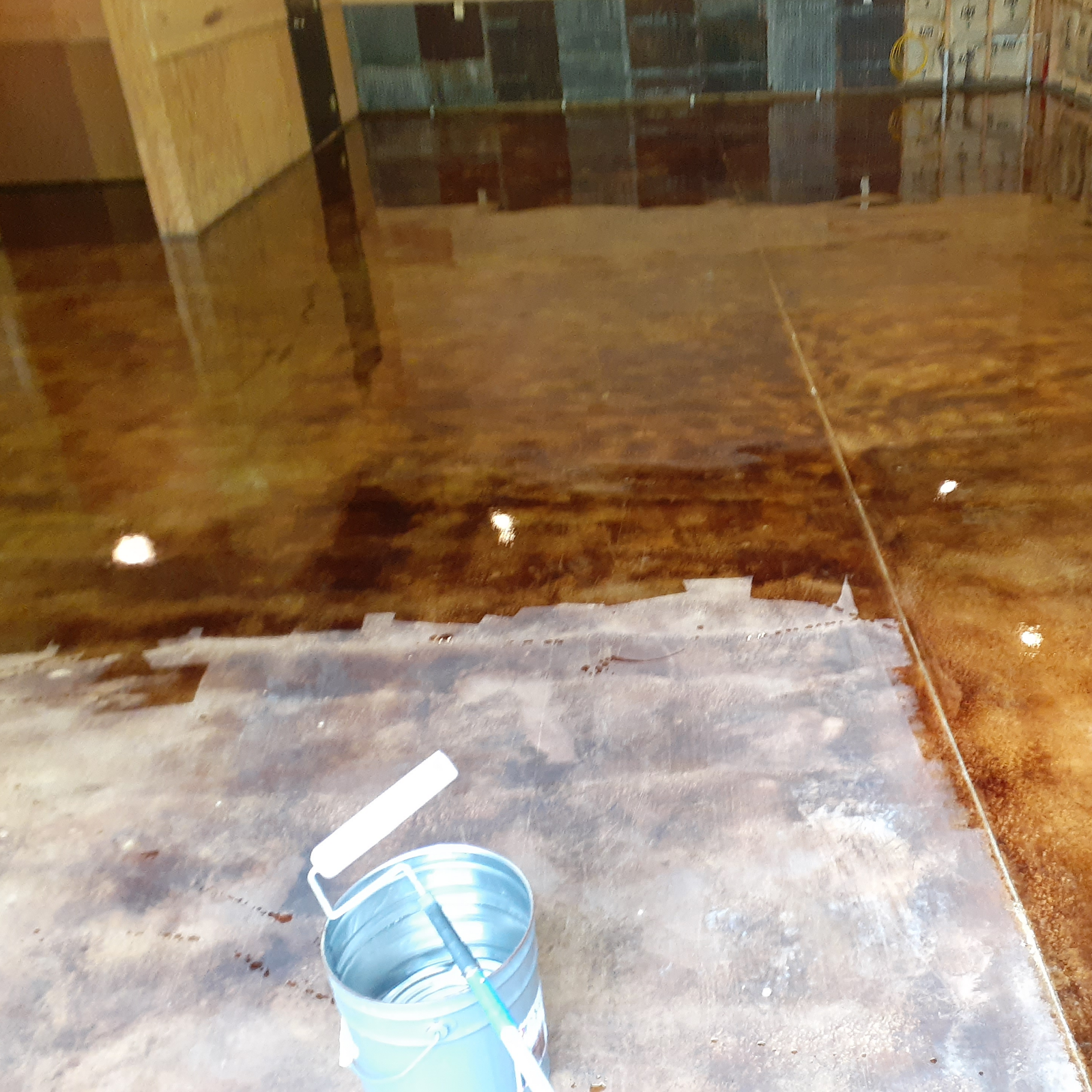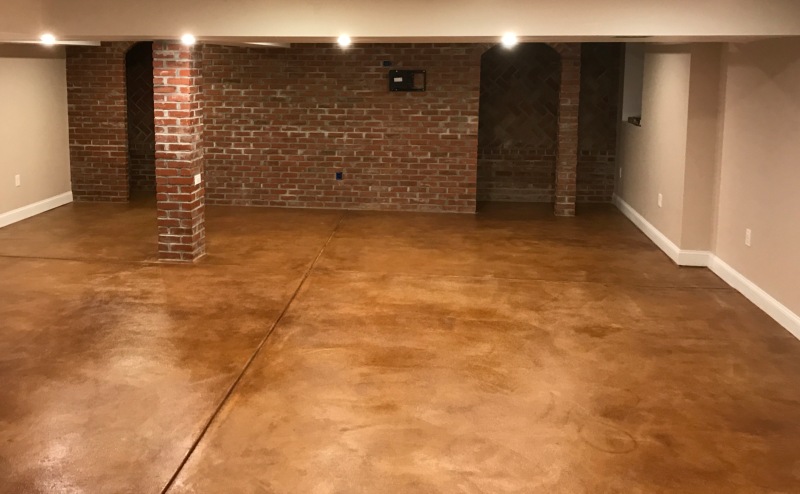Recognizing the Various Types of Stained Concrete for Your Next Project
Stained concrete deals various options that accommodate different aesthetic and practical requirements. Each type offers distinctive features that affect the last appearance and durability of the surface. Understanding these distinctions is key for any individual preparing a task. From rich, chemical responses of acid-based stains to the dynamic harmony of strong shade stains, the choices can considerably influence the end result. What aspects should one consider when picking the excellent discolor for their particular demands?
Review of Stained Concrete
Stained concrete serves as a functional floor covering choice that can improve the aesthetic appeal of various rooms. This strategy involves using a coloring agent to the surface area of existing concrete, permitting a broad range of design opportunities. Stained concrete is prominent in both residential and commercial environments, providing a resilient and low-maintenance option that can simulate the appearance of natural materials like stone or floor tile.
The staining procedure can be performed making use of water-based or solvent-based products, each offering distinct visual effects. The last appearance is influenced by variables such as the original concrete surface area, the kind of stain used, and the application method. Stained concrete not only improves exterior and interiors but likewise promotes sustainability by revitalizing existing concrete frameworks. Because of this, it has gotten grip amongst house owners and designers seeking both functionality and design in their flooring selections.
Acid-Based Stains: Characteristics and Benefits

Unique Shade Variations
Concrete surfaces can transform drastically with the application of acid-based stains, which supply a rich palette of unique color variations. These stains pass through the concrete, reacting chemically to produce vivid planet tones that vary from deep browns and reds to soft environment-friendlies and blues. The resulting hues are often variegated, developing an all-natural, marble-like appearance that improves the concrete's personality. Each application yields unique results because of variations in the concrete's make-up and the staining technique made use of, making every task unique. Furthermore, acid-based stains can be layered or incorporated with other strategies to produce tailored styles, enabling personal expression. This flexibility makes acid-based stains a preferred selection for both residential and business applications.
Chemical Reactions Discussed
While several factors contribute to the efficiency of acid-based stains, the underlying chain reaction play a crucial function in their special features and benefits. These stains mostly contain water, acid, and metal salts. When applied to concrete, the acid reacts with the calcium hydroxide in the concrete, producing a chemical improvement that causes permanent shade changes. The metallic salts permeate the surface and bond with the concrete, permitting a variety of shades and tones. This response not just enhances visual charm yet likewise supplies sturdiness, making the shade immune to fading and wear. In addition, acid-based stains can create a variegated finish that resembles natural rock, more improving their popularity for attractive concrete applications.
Surface Preparation Relevance
Achieving perfect outcomes with acid-based stains depends upon complete surface prep work. This important step warranties that the concrete surface area is tidy, cost-free of contaminants, and properly profiled for ideal discolor absorption. Any type of existing sealers, dirt, or oils can hinder the chain reaction that creates the desired shade and surface, causing irregular or patchy outcomes.
Before applying the tarnish, the concrete needs to be mechanically cleaned or stress washed, adhered to by a comprehensive inspection for fractures or blemishes that may require repair service. In addition, confirming the surface area is properly dried will certainly enhance discolor adherence. By focusing on these primary steps, the long life and vibrancy of acid-based stains can be substantially boosted, resulting in a much more cosmetically pleasing and sturdy coating.
Water-Based Stains: Attributes and Advantages

Water-based stains pass through the concrete, using a much more translucent coating that highlights the natural texture and variations of the surface area beneath. They are readily available in a wide range of shades, enabling creative versatility in layout. Additionally, water-based stains are easier to cleanse up, requiring only water and soap, which simplifies the application procedure.
Their fast drying out time enhances efficiency, making them a useful selection for both DIY lovers and specialists. On the whole, water-based stains provide an appealing mix of aesthetic versatility and user-friendly homes, making them a popular choice for concrete improvement jobs.
Solid Shade Stains: Lively Choices for a Bold Look
Strong color stains supply a reliable option for those seeking to create a strong and vibrant aesthetic on concrete surface areas. These stains offer a consistent pigmentation that can significantly enhance the aesthetic charm of floorings, patios, and driveways. Readily available in a vast range of hues, strong color stains permit innovative expression, satisfying various design preferences.
One of the essential advantages of solid color stains is their capacity to conceal blemishes, providing a fresh and sleek seek to aging concrete - stained concrete floors. In addition, their solution usually consists of UV-resistant buildings, making sure long life and shade retention even in extreme climate condition
Application is straightforward, needing very little prep work of the concrete surface. Once used, strong shade stains can be secured for added defense and shine, more boosting their visual quality. With their vivid alternatives, strong color stains are a superb option for those going for an impactful and cohesive style.
Semi-Transparent Stains: Accomplishing Deepness and Dimension
Semi-transparent stains supply an unique technique to enhancing concrete surfaces by offering depth and dimension via numerous color options. Recognizing the application techniques is vital for accomplishing the wanted result, while appropriate upkeep methods ensure long life. This section will certainly check out these crucial elements to take full advantage of the benefits of semi-transparent staining.
Color Options Available
A wide array of color alternatives exists for semi-transparent stains, allowing home owners and developers to enhance the all-natural appeal of concrete surfaces. These stains are available in a range of shades, from earthy tones like browns and terracottas to vivid shades such as blues and environment-friendlies. The semi-transparent nature of these stains enables the underlying concrete to show through, producing a distinct deepness and dimension that can complement various layout aesthetic appeals. Furthermore, combining different colors can produce customized shades, enabling a tailored appearance for each task. find here This flexibility makes semi-transparent stains a popular choice for both exterior and interior applications, as they can integrate with surrounding aspects while including visual passion to simple concrete.
Application Methods Clarified
To accomplish the wanted deepness and dimension with semi-transparent stains, appropriate application methods are important. Initially, surface area preparation is essential; the concrete needs to be clean and without any kind of impurities. This usually includes power cleaning and repairing any fractures. Next, picking the best applicator, such as a sprayer, roller, or brush, can affect the last appearance. Sprayers enable a more even application, while rollers can assist attain appearance. It is vital to use the discolor in thin, also layers, allowing each layer to completely dry prior to adding an additional. Controling the application method, such as varying pressure or utilizing different devices, can create one-of-a-kind effects. Finally, sealing the stained surface improves the vibrancy of the colors while offering protection.
Upkeep Finest Practices
Routine maintenance is vital for maintaining the charm and integrity of surface areas treated with semi-transparent stains. To preserve these surface areas, regular cleaning is essential. Utilizing a pH-neutral cleaner and a soft-bristle mop will aid get rid of dirt and debris without damaging the stain. It is a good idea to stay clear of extreme chemicals, as they can break down the tarnish's appearance. Additionally, routine resealing each to 3 years can protect against wear and fading. This process involves cleansing the surface area extensively and using a suitable sealant created for stained concrete. Home owners ought to likewise monitor for any type of indicators of staining or damage and address these issues promptly to assure resilient vibrancy and durability. Complying with these ideal practices will boost the overall life-span of semi-transparent stained surface areas.
Results and Strategies: Personalizing Your Stained Concrete
Personalizing stained concrete entails a range of methods that enhance both aesthetic appeals and capability. Amongst these techniques, layering various tarnish shades can develop depth and complexity, enabling for one-of-a-kind aesthetic impacts. Techniques such as acid discoloration offer a variegated look, while water-based stains offer an extra uniform appearance.
Furthermore, including decorative patterns, such as stenciling or engraving, can additionally customize the surface, adding detailed layouts that provide to specific preferences. Texturing the concrete, whether with marking or mop finishes, introduces tactile elements that not just boost grasp but likewise enhance aesthetic rate of interest.
Moreover, using sealants can magnify the shade vibrancy and supply protection versus wear. Customization strategies expand beyond plain shade; they can transform a basic concrete piece into a stunning prime focus, making it appropriate for both household and industrial rooms. Via cautious selection of effects and strategies, stained concrete can attain a genuinely customized look.
Maintenance and Longevity of Stained Surfaces
Stained concrete surfaces are recognized for their longevity and visual charm, preserving their honesty is important for ensuring longevity. Regular cleaning is vital; check my site sweeping and wiping with a pH-neutral cleaner aids avoid dust buildup and discoloration. Furthermore, applying a sealer every few years can protect the surface from wetness, chemicals, and UV damages, consequently improving its lifespan.
It is additionally crucial to resolve any splits or chips quickly. Small repair services can minimize additional damage, maintaining the aesthetic and structural high quality of the surface. For outside stained concrete, seasonal upkeep, such as removing snow and ice, is necessary to prevent surface area damage from freeze-thaw cycles.
Regularly Asked Concerns
Can I Stain Existing Concrete Surfaces or Brand-new Ones?
The concern of whether existing concrete surfaces can be stained arises frequently. It is certainly feasible to stain both brand-new and Visit Your URL old concrete, gave the surface area is sufficiently ready and complimentary of contaminants for suitable bond.
For how long Does the Discoloration Process Typically Take?
The discoloration process generally takes one to three days, depending upon elements such as surface prep work, type of discolor, and weather. stained concrete. Treating time may extend beyond preliminary application, affecting the general period substantially
Is Stained Concrete Safe for Outdoor Use?
Stained concrete is generally safe for outdoor use, offered it is correctly sealed. This sealing shields versus moisture and UV damages, making certain resilience and safety, while likewise improving the visual allure of exterior areas.
Can I Apply Multiple Spot Layers for Various Impacts?
Using multiple tarnish layers can attain diverse impacts on stained concrete. It is important to guarantee compatibility in between stains and allow correct drying out time in between applications to prevent unintentional reactions or discoloration.
Are There Any Type Of Color Limitations for Stained Concrete?
Color constraints for stained concrete largely rely on the sort of discolor utilized, with water-based stains using a more comprehensive scheme contrasted to acid-based stains. stained concrete contractors. Nonetheless, achieving vibrant shades might need cautious option and application methods